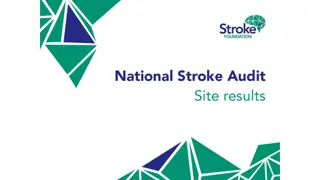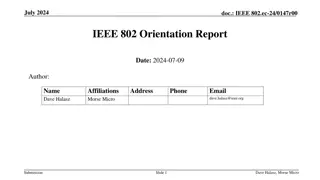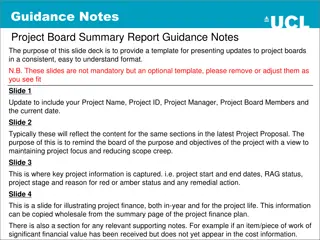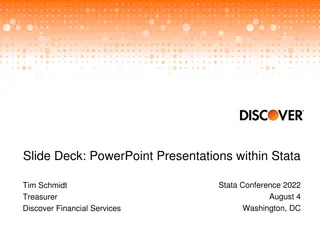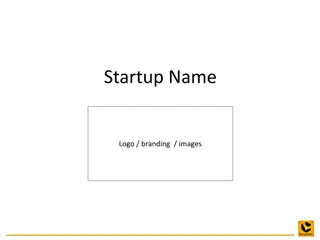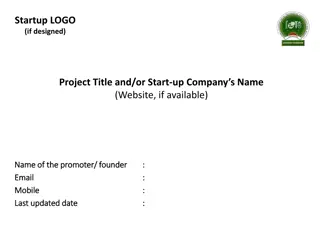Partnering with PLEE on a Data Project Orientation Deck
Slide deck template designed to onboard individuals with lived experience of homelessness onto data projects. The deck covers topics such as data foundations, types of data, qualitative data, and participant introductions. It aims to support CoC and homeless systems leaders in facilitating orientation sessions aligning with HUD's guidelines. Customize the template to suit your community's needs.
Download Presentation

Please find below an Image/Link to download the presentation.
The content on the website is provided AS IS for your information and personal use only. It may not be sold, licensed, or shared on other websites without obtaining consent from the author. Download presentation by click this link. If you encounter any issues during the download, it is possible that the publisher has removed the file from their server.
E N D
Presentation Transcript
Key Data Terms and Types Slide Deck Template #2 Partnering with PLEE on a Data Project
The Purpose of the Orientation and Onboarding Deck How to Use this Deck: This deck is intended to support CoC and other homeless systems leaders with on-boarding people with lived experience of homelessness on data projects. Please note: These slides offer a template, but do not need to be used in full. Take what works for your community! Throughout the deck, there are [brackets] to indicate places where systems leaders should fill in locally-specific information. As drafted, this slide deck will take approximately 1 hour to facilitate. The deck aligns with HUD s How to Partner on a Data Project webpage and accompanying materials.
Orientation Agenda Welcome and Introductions Discussion: Data Foundation Discussion: What is Data & Types of Data Discussion: Types of Data: Why Do They Matter Evaluation and Reports
[Speaker Introduction] [Introduce the speaker and organization leading the data project. Potential speaking points could include: Purpose of the organization leading the data project Other projects the organization has worked on that the audience might be familiar with Speaker s experience on similar data projects Other names that the audience might recognize the lead organization by Fun fact about the speaker.] - - - - -
Participant Introductions Name Pronouns [One Ice Breaker Question] [Ice Breaker Example 1: What s your favorite summer food?] [Ice Breaker Example 2: What color do you think is the best representation of your personality?] - -
What is Data? How information is gathered
Qualitative Data is Typically anything that is not numeric Appropriate for answering how and why questions Collected through a variety of methods Interviews and focus groups Open-ended survey questions Observations Document reviews - - - -
Quantitative Data is Measurable and numeric Often used for comparisons Counts, percentages, statistics Appropriate for answering questions like Who, What, When, Where - - - - Collected through a variety of methods Client records: Homeless Management Information System (HMIS) Closed ended surveys Structured interviews - - -
What is HMIS? The Homeless Management Information System (HMIS) is a data collection system. All providers offering services to individuals experiencing homelessness can enter data into HMIS. HMIS usually holds data about individuals. For example: Demographic Information Living Situation Participation in Services Destination at exit
What is HMIS (continued) HMIS can help us answer questions about how the homeless system is functioning. Here are examples of questions that could be answered using HMIS data: How long are individuals staying in shelters? When individuals stay in transitional housing, where do they typically go next? Do certain racial groups access permanent housing more frequently than others?
HMIS Data The HMIS Data Dictionary has every required element Data is organized by project, household, and individual There are data that every project collects, most projects collect, and some that only some projects collect. The types of data collected fall into several categories Demographics Homelessness and housing experiences Interactions with homelessness system Outcomes However, there is a ton of information that HMIS alone cannot tell us! - - - -
Who Owns the Data in a HMIS? People accessing services, the people data is collected from, own their data! The CoC are stewards of that data. The CoC is obligated to provide people served with a copy of their complete HMIS file upon request. The CoC is obligated to delete data from HMIS upon requests.
Qualitative and Quantitative Data Why Both Types of Data Matter?
Why Qualitative Data is Important Qualitative Data - Helps to access the thoughts and feelings of participants, which can enable development of an understanding of the meaning that participants ascribe to their experiences. Typically anything that is not numeric Appropriate for answering how and why questions Collected through a variety of methods Interviews and focus groups Open-ended survey questions Observations Document reviews
Why Quantitative Data is Important Quantitative Data: Is helpful when trying to understand something that can be counted and expressed in numbers. It can be tested and checked Measurable and numeric Often used for comparisons, finding trends and viewing the full scope Counts, percentages, and statistics Appropriate for answering questions like who, what, when, and where In the CoC Typically collected through a homeless management information system or other data repository Demographics (e.g., race, gender, age) Outcomes (how many people increased their income, how many exited to permanent housing?) Comparisons (Did different groups achieve different outcomes?) - - - -
Benefits of using both kinds of Qualitative and Quantitative Data Both qualitative and quantitative data are important for making informed decisions When used together, they can provide insights into what is working and what is not in the homelessness response system Example: Quantitative data can tell you that more youth of color left a project before obtaining permanent housing and qualitative data can provide insights into why this might be happening -
Impact of Data: What It Can Lead To Providing an avenue to share experiences and inform the system Tracking the attainment of goals Helping to ensure services are delivered in a timely manner Helping to advocate for raising more money for more resources Empowering efforts to improve services
Data Accuracy Helps ensure correct housing placements and service referrals Other pieces of data accuracy that are just as important include: All clients served are entered into the system All clients exited have been exited from the system Helps to look at utilization Inaccurate data can distort or reduce value of information acquired - - - -
Evaluation and Report HUD and CoC use data to evaluate projects and data is connected to performance, which is connected to funding Data typically comes out in pre-programmed reports in the HMIS and is uploaded into a variety of data repositories for review and evaluation CoCs may have custom dashboards or data warehouses to evaluate their own data
Examples of Common Data Reports Annual Performance Reports (APR): Information about individuals accessing unique projects. Longitudinal Systems Analysis (LSA): Information about how individuals move through the system. System Performance Measures: Information about the performance of the system. (SPM 2015-2021) Point-in-Time Count: A snapshot count of people experiencing homelessness on a single night in January. Housing Inventory Count: Inventory of bed and units in the community.
Discussion (1) Review HMIS Data points - do these make sense? What's missing? (2) Work on developing questions for a survey or listening session (3) Talk about the impact of the data and project on the system of care.


